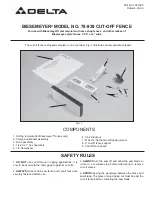
Grouting
Grouting refers to the process of filling the
spaces between the individual tiles and
thus completing the floor surface. Before
grouting can commence, the adhesive used
must have cured, which usually takes
between 12–24 hours for
Fired Earth Floor
Adhesive*
and 3 hours for
Fired Earth
Fastset Adhesive*.
The depth of adhesive,
ambient temperature, porosity of the tile
and subfloor will all affect the curing time.
The joints to be grouted should be clean,
dry and free of loose debris and excess
adhesive. The addition of
Fired Earth
Flexibond*
will increase durability and
impart flexibility to the grout.
Fired Earth
Flexibond*
should be added to the grout
when tiling onto timber floors prepared
with WBP plywood, floating floors, tiles
over underfloor heating and 'wet floors'.
It is advisable to grout and clean a small
‘test’ area prior to grouting the whole floor.
This will give you the opportunity to check
that all grout can be removed without
staining the tiles and that you are happy
with your chosen colour.
Pointing and Slurry Grouting
Pointing is the careful application of grout
between the tiles avoiding contaminating
the surface of the tile by using a damp
sponge to wipe off any excess.
Slurry grouting is the method of grouting
involving a wet mix, or slurry of grout
being spread over the whole of the tile
surface, as well as into the grout joints. The
slurry is then pressed with a ‘grout float’ or
squeegee into the grout lines and into any
pits in the surface of the tile. Any surplus
should be wiped off the tiles particularly
before it starts to dry with a clean damp
sponge, continuously washing the sponge
using clean warm water.
The addition of
Fired Earth Flexibond*
into
the grout makes removal of surplus grout
more difficult, so it is important to clean as
you grout.
Grout should be pushed well down into the
joints so that no air pockets exist and the
joints are fully filled. The more the grout is
compacted the harder it will set. A timber
dowel of the appropriate diameter may be
used to assist in compacting the grout.
Smooth off the joints and remember that
the main purpose of grouting is to
strengthen the overall floor and, in order to
achieve this, the grout must fully support
the edges of all the tiles.
Fired Earth offers grouts for floors in
three colours,
Sandstone
,
Grey
and
Limestone*
. We do not recommend the use
of strong pigmented grouts which are
more likely to stain the tile. As soon as
the floor is finished and the grout has
completely dried, the tiles should be
thoroughly cleaned to remove any stains
or fine dust particles.
Terracotta Tiles
(except Presealed Terracotta)
Sealing
Fired Earth recommend Terracotta tiles are
sealed
with Fired Earth Linseed Sealer*
prior to fixing. We would advise that a
number of sample tiles are tested for
porosity, from which an indication of the
amount of sealer that the tiles will absorb
can be gauged.
Using a clean, short haired paint roller or
brush, work the sealer into the surface so
that the tile appears matt again within 10
minutes. If the tile regains its matt
appearance too quickly, use the sealer a
little more liberally.
The tiles will readily absorb the first coat of
sealer and, as a rough guide, you should
expect to use up to 75% of the sealer on
the first coat. Within 20 minutes of applying
the sealer, check that there is no surplus
remaining on the surface of the tiles.
Wipe away any surplus sealer with a clean,
dry cloth. If oil is allowed to remain on the
surface for 20 minutes or more, it is likely
that the oil will begin to turn tacky or hard,
which will necessitate remedial work. The
final seal can only be carried out once the
grouting has completely dried.
Take particular care during the application
of the second coat of sealer as the tile is
now partially sealed and will absorb less
sealer than the first coat. Apply a second
coat to a small test area to gauge how
much sealer the tiles are likely to absorb.
Remember the oil should soak in within 20
minutes of application and the tiles should
be matt in appearance.
Finishing
Option A - Wax Polish
Once sealed, Fired Earth’s traditional
method of finishing terracotta is for
Fired
Earth Wax Paste*
to be applied. This
enhances the natural colours within the
clay and provides protection against
staining. Apply the first coat as soon as
possible after the sealer has dried. The wax
should be applied sparingly, allowed to
harden then buffed to form a hard,
protective finish. For a newly installed floor,
Fired Earth Wax Paste*
should be applied
once a week for the first 4–6 weeks, in
order to build up a hard wearing surface.
Option B - Cotto Rapid*
As an alternative finish, providing less
protection but requiring less maintenance,
Cotto Rapid*
can be applied once the tiles
have been sealed for the second time.
Ensure the sealant is completely dry before
application of this product. Two to three
coats should be applied sparingly with a
clean cloth, allowing sufficient drying time
between coats.
Cotto Rapid*
should be re-applied once or
twice per year.
Cotto Rapid*
is not
recommended for use on Fired Earth Antique
11
10





















